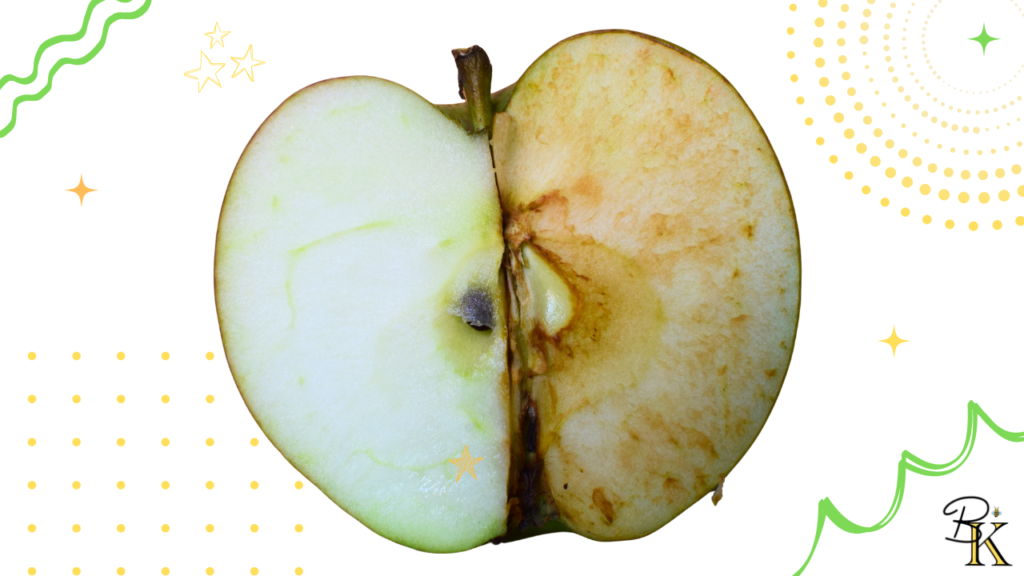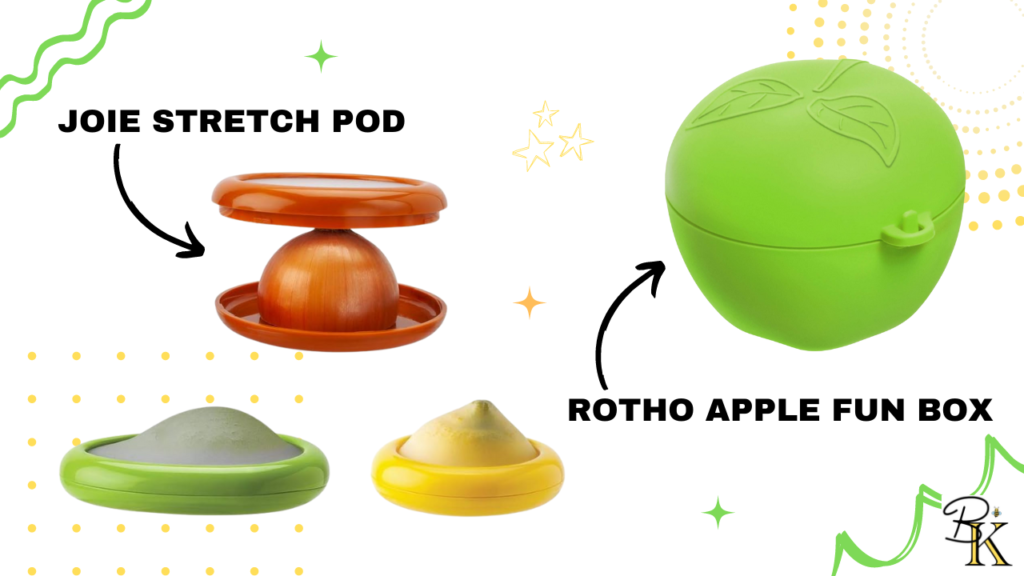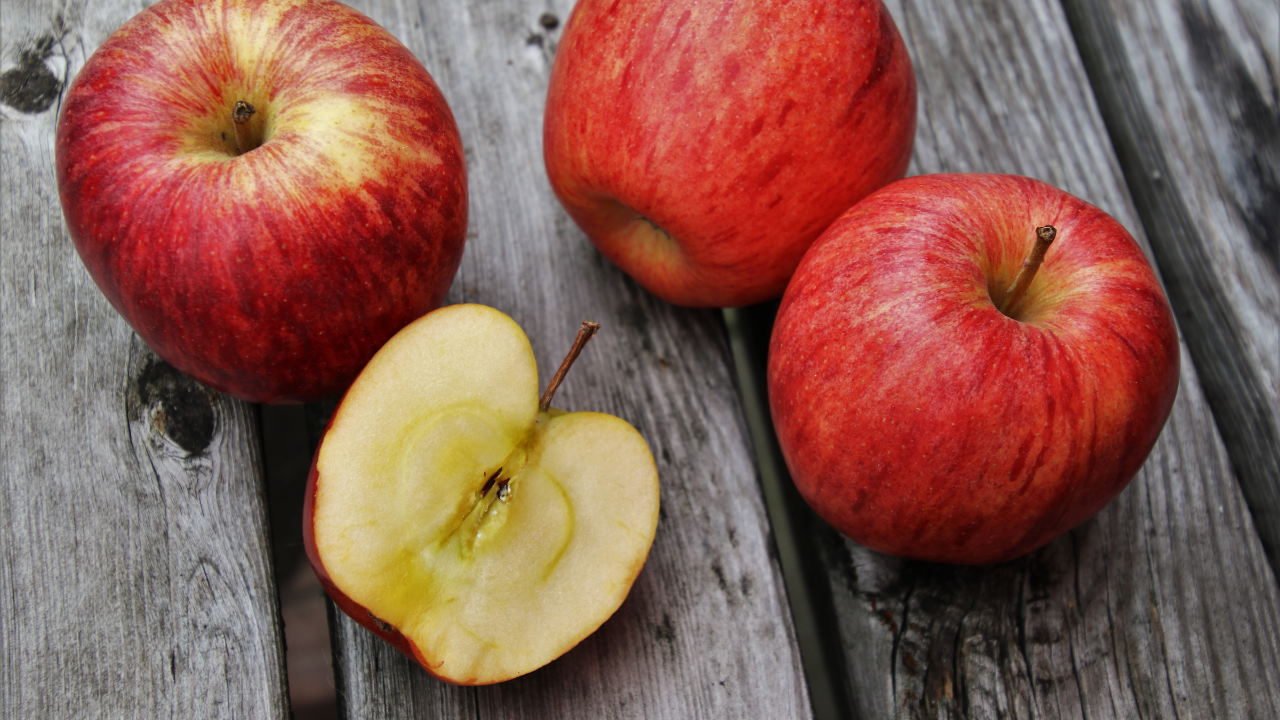Some of the links on this page are affiliate links, which means that Buzzy Kitchen earns commission from purchases made – at absolutely no extra cost to you. Thank you so much for supporting Buzzy Kitchen!
There’s nothing worse than popping an apple down, doing something around the house, and then returning to fruit that has started to turn brown. It’s especially worse on hot summer days when the temperature makes the browning process considerably faster. Thankfully, there are plenty of things you can do, to slow down and even stop apples turning brown.
Please, allow me to tell you all about them.
Why Do Apples Turn Brown When You Cut Them?
The browning of apples is down to something called enzymatic browning. It sounds very complicated, but I promise you, it’s not. Let me break things down.
First of all, when you cut an apple, you damage the cell walls of the flesh inside. The skin is the protective layer, so when you cut through that, even with a tiny cut, the protective barrier has been broken and the cells inside become vulnerable. Bruising can also cause weakened or damaged cells within the flesh, without the need for a cut.
When the cells are weakened, PPO – polyphenol oxidase, comes into contact with other, naturally occurring amino acids and enzymes within the flesh of the apple. PPO enzymes are naturally present in foods that turn brown and are the reason they change colour in the first place.

The enzymes all react together, and with oxygen, to cause oxidation, and the PPO speeds things up. That series of chemical reactions is what makes apples turn brown when you cut them – enzymatic browning.
Apples aren’t the only produce affected by enzymatic browning. Avocadoes, bananas, potatoes, pears, grapes, mangoes, and many others also turn brown when the flesh is cut and comes into contact with oxygen in the air.
How Long Does It Take Apples to Turn Brown?
Lots of factors come into play when determining how long it takes apples to turn brown. Ambient temperature, age and quality of the apple, and how the fruit is stored will either shorten or lengthen the apple’s non-browning time.
When you cut or bite into an apple, the enzymes in the fruit’s cells react with oxygen from the air. This reaction starts immediately upon exposure. In the first few minutes, you may notice a slight colour change around the cut or bitten area. This is often the initial stage of enzymatic browning.
Within around five or ten minutes, the browning process becomes more noticeable, and the exposed surface of the apple starts to take on a brownish tint. This is due to the formation of melanin-like pigments in the presence of oxygen.
The browning process continues until, after around thirty minutes, the discolouration spreads to more of the fruit’s flesh.
Some apple varieties are prone to browning quicker than others, and the temperature around the apple will play an important factor, too. The warmer it is, the quicker the apple will turn brown and then bad, which is why it’s recommended to store the fruit in the fridge once you have cut it.
14 Ways to Stop Apples Turning Brown
There are lots of ways in which you can stop apples turning brown. Everyone seems to have their own favourite method of doing it. I’ve trawled the internet, asked my mother-in-law, spoken to my grandparents, and even asked a few of my friends, and I think I’ve found some of the best, common, and least-known approaches to keeping your apples fresh and not brown.
And here they are:
1: Store Cut Apples in an Airtight Container
At the very least, apples that have been cut should be stored in a container that is completely airtight. Because the oxidation process occurs when air contacts the flesh of the apple, an airtight container helps to form a barrier and slow the process considerably.
An airtight container is essentially a Tupperware-style tub, or any other container that has a lid and can be sealed completely shut. No air in, and no air out.
2: Use Cling Film or Foil
If you don’t have an airtight container, you could use foil or cling film (plastic wrap). You should use two or more layers to ensure you have created an adequate airtight barrier. I personally wrap apples in two layers of cling film and then a layer of aluminium foil after that, but you just need to make sure that the barrier seals the apple in and keeps air away.
3: Invest in an Apple Container
What’s an apple container? I hear you ask. Well, it is essentially an airtight container that is designed to keep apples and other types of fresh produce nice and fresh for as long as possible. They’re airtight, washable, and reusable, and great for lunch boxes, saving-for-later moments, and more!
There are two particular products in this category that I, personally, love and use. These are the Joie Stretch Pod, which is designed for onions, lemons, and avocado halves, but work well for apple halves, too.
The other product is the Rotho Apple Fun Box, which is actually shaped like an apple. I love it for that reason alone, to be honest, but it does have really great reviews. Just like the Joie Stretch Pod, the Fun Box is reusable, washable, BPA-free, and airtight for fresh produce saving.

4: Store Cut Apples in Water
I know it sounds a bit weird, but keeping apples submerged in water is a great way to stop them from browning, because it keeps oxygen away from the inner flesh. The apple will absorb a little water, but not enough to affect the taste. You could probably do with a little more water in your diet anyway. (I’m projecting.)
If you don’t like the idea of water coming into contact directly with your apple, you can always wrap the halves or apple bits in kitchen paper towel before submerging in water. If you have an airtight container, wrap the apple in kitchen towel, then submerge in water, then pop the top on. There’s no way your apple will go brown quickly with all of those measures in place!
5: Dunk in Lemon Juice (Neat)
Lemon juice is one method recommended on the internet for stopping cut apples turning brown. It is the citrus and acidic parts of lemon juice that prevents apples from browning, but you can expect taste changes that grow in intensity the longer you leave the apple submerged.
For that reason, most people like to dunk the apple pieces in lemon or other citrus juices, before then removing them and wrapping them in kitchen towel or storing in an airtight container, which is the best option.
I don’t usually find the taste sticks for too long with lemon juice, to be honest. If it ever bothered me, I’d just give the apple a quick rinse under a cold tap.
You could do the next method instead.
6: Submerge in Diluted Lemon Juice
Rather than dunking your apple pieces or halves into pure lemon juice (or other citrus juices,) you could use diluted lemon juice. You’ll use less of it, and the citrus taste will transfer across even less, if that’s something that concerns you.
After you have briefly submerged the apple into the diluted citrus juice, pop them into an airtight container, wrap them up in cling film or foil, or, for short term, wrap in kitchen towel.
In terms of citrus juice, the following are recommended by experts:
- Lemon
- Pineapple
- Orange
- Lime
7: Use 7Up or Ginger Ale
7Up, ginger ale/beer, and other fizzy drinks that contain citric acid is another smart way to stop apples from turning brown. You must remember, however, that the apple can absorb some of the flavour from whatever fizzy drink you use, so it’s recommended to dunk-and-store as recommended previously.
Another way to minimise the transfer of flavour from storage solution (such as lemon juice or 7Up) is to add an ingredient that neutralises or dulls them. You can use fresh apple juice if you have it, or apple cider.
8: Soak in a Honey-Water Mix
Another great, sweet approach to stopping apples turning brown is to use a mixture of honey and water. Add one tablespoon of honey to 125ml of water, then stir until the honey has been completely broken down and mixed in with the water.
If your honey is super thick or difficult to stir in, you can use warm water. Just remember to let the honey-water mixture cool down before you submerge your honey halves or pieces; otherwise, you might end up partially boiling them.
9: Sprinkle with Citric Acid
I know the word ‘acid’ brings not good feelings, but citric acid is a weak organic acid that occurs naturally in citrus fruits, particularly in lemons. It is a key component in the citrus flavour of these fruits, and the chemical formula of citric acid is C6H8O7.
The acid is found in all citrus fruits, such as:
- Lime
- Tangerine
- Grapefruit
- Orange
- Pomelo
- Kumquat

Now that we’ve gotten that out of the way, let’s get to how you can use it to stop apples turning brown. You don’t need to use a lot; only ¼ to ½ of a teaspoon of citric acid in powdered form, either diluted in water or sprinkled directly over the fruit itself. You must use food-grade and food-safe citric acid. Not all citric acid is safe to use with food.
After around five minutes, wash the apple pieces thoroughly with cold water. You’ll want to get all of it off, so that it doesn’t alter the taste of the apple when you do choose to eat it.
After that, pop the apples into an airtight container, then into the fridge. It’s just a secondary version of using lemon, lime, or other citrus fruit juices.
10: Dunk Cut Apple in Brine
Brine, also known as salt water or salted water, is another recommendation for stopping apples and other fruits and vegetables from oxidizing and turning brown. Salt is well known for being a great preserver, so it’s not really a big surprise that you can use it to stop apples turning brown, too.
Mix a pinch of salt with approximately 125ml of cold water, then stir well. Submerge the apple pieces into the mix, only for thirty seconds or so, then rinse with unsalted cold water. After that, store the apple pieces in an airtight container (or wrapped in cling film/foil,) and in the fridge.
12: Use the Rubber Band Method
If you have two halves of an apple (or close to that,) you can pop them together so that the flesh on both apples touch the other. Then, use a clean rubber band to hold the apple together. When you’re done, your apple should like a regular apple, held together with the band.
By putting the flesh of the apple together, you’re preventing air from getting to it. This, in turn will stop apples turning brown. The elastic band simply holds it all together.
You should, once again, store it in the fridge until you’re ready to eat it.
13: Use Vitamin C Powder
If you just so happen to have powdered vitamin C in your home, you can use that to stop apples turning brown, much in the same way as with citric acid. If you don’t have powder, you could always use vitamin C tablets that are designed to dissolve in water.
Simply use a little of the powder in water, mix well, and then dunk your cut apples in the liquid. Just as with the rest, store in an airtight container, in the fridge, for long-lasting results.
14: Always Refrigerate Cut Apples
Regardless of how you decide to store your cut apples, always keep them in the fridge. The chilly temperature is designed to slow the process of food turning bad! You might as well use the appliance, right? You are paying for the energy to run it, and all that.
TOP TIP
Don’t be afraid to double-up on the tricks when it comes to stopping your cut apples turning brown. Cover your apple slices in lemon juice and then keep them in an airtight container, for example. (The latter is non-negotiable if you want your apples to last.)
How to Stop Apples Turning Brown: Conclusion
So, there you have the 14 ways to stop apples turning brown. What do you think? Which one do you already use? For me, it’s diluted lemon juice, an airtight container, and the fridge – but what’s your preference?
I hope you’ve found the answers to your questions today, but why not take a peek at one or two of the following while you’re here?
- How to Make Vegan German Apple Cinnamon Pancakes
- Can You Eat a Balsam Apple?
- Red Apples vs Green Apples: What’s the Difference?

